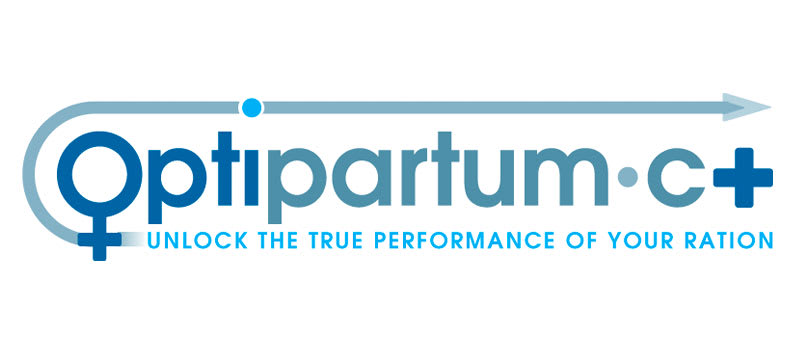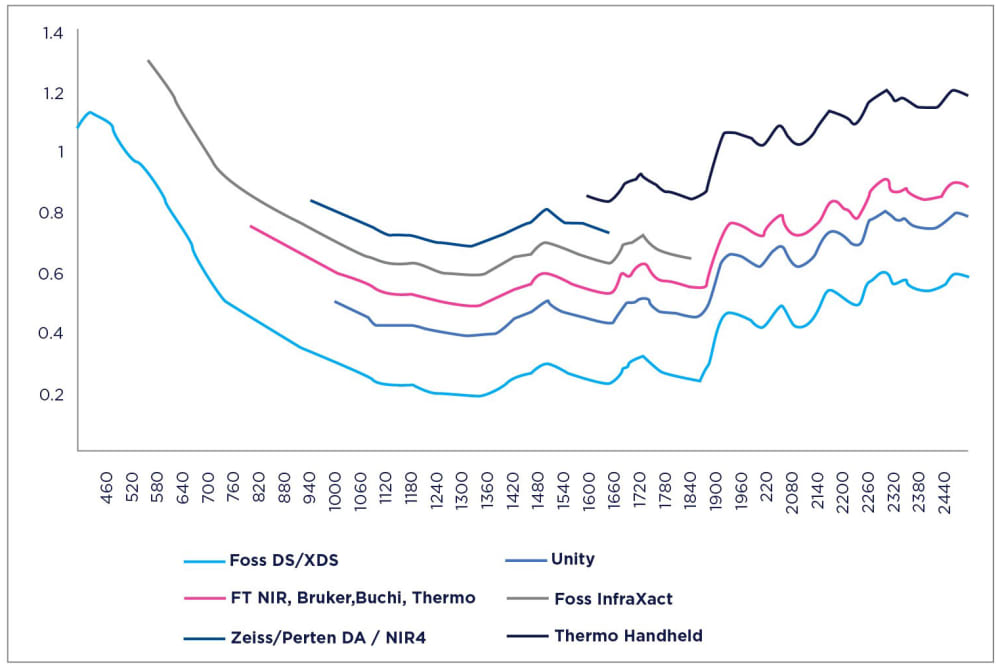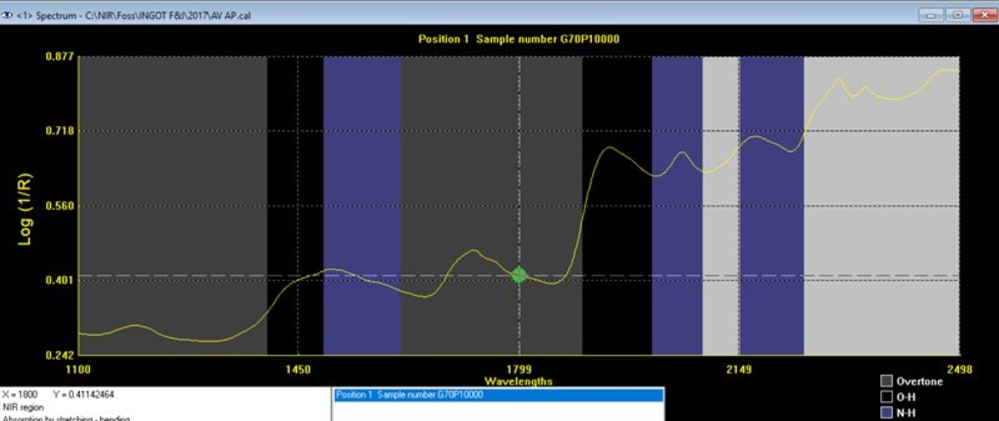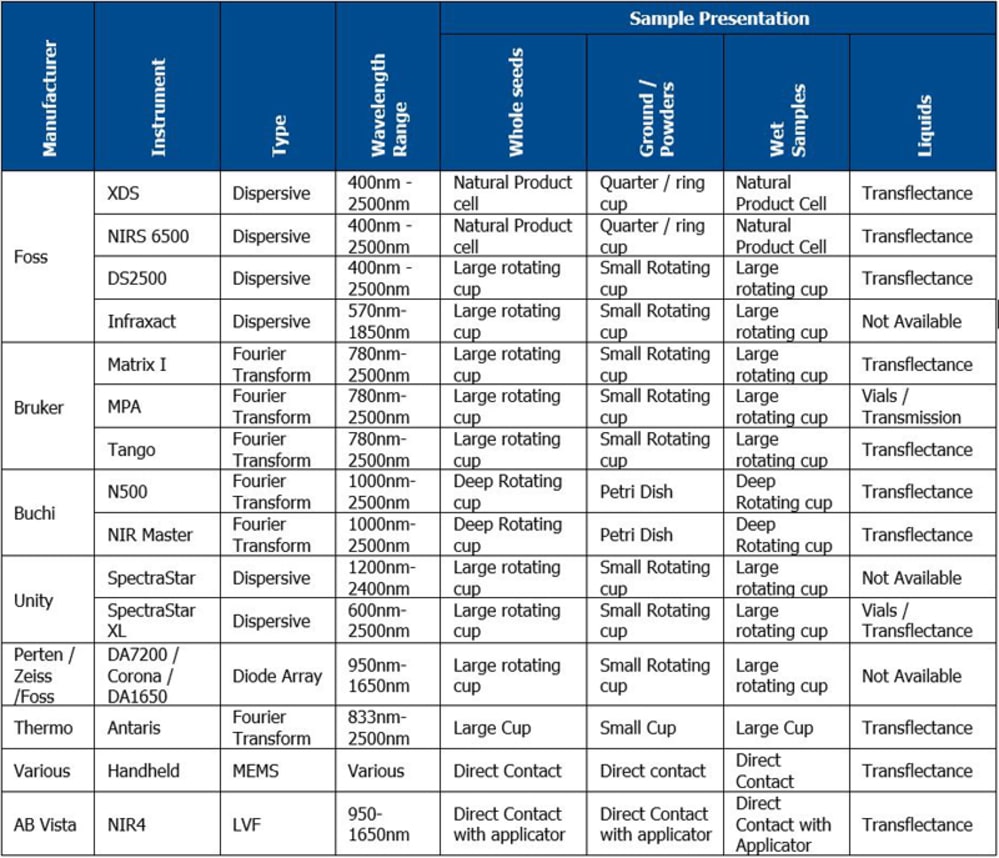Understanding the differences between NIR machines
Published Thursday, 14th June 2018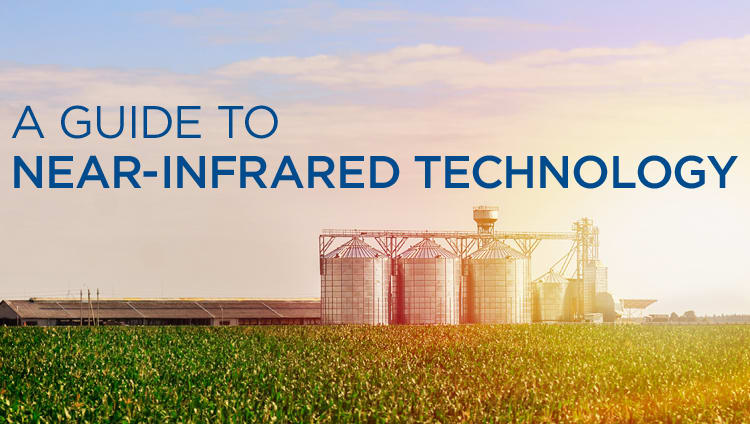
There are a number of different Near-Infrared Spectroscopy instruments on the market and in general they can be split into five main groups according to how they generate spectra. In the first in a new series of articles exploring NIR, we take an in-depth look at these machines.
1. FT-NIR (Bruker, Thermo, Buchi)
A Fourier Transform (FT)-NIR instrument uses a system called an interferometer to collect a spectrum. The interferometer consists of a source, beam splitter, two mirrors, a laser and a detector. The energy goes from the source to the beam splitter, which splits the beam into two parts. One part is transmitted to a moving mirror; one part is reflected to a fixed mirror. A very precise laser wavelength in the system is used to control the moving mirror and also acts as an internal wavelength calibration.
The two beams are reflected from the mirrors and recombined at the beam splitter. The beam from the moving mirror has travelled a different distance than the beam from the fixed mirror. When the beams are combined, some of the wavelengths recombine constructively and some destructively, which creates an interference pattern. This interference pattern is called an interferogram.
This interferogram then goes from the beam splitter to the sample, where some energy is absorbed and some is transmitted. The transmitted portion reaches the detector. The detector reads information about every wavelength in the infrared range simultaneously.
An algorithm called a Fourier transform is performed on the interferogram to convert it into a spectrum. One major benefit of FT-NIR is that the wavelength axis is very precise due to the internal laser. This means that transfer of calibrations between instruments is very good.
2. Dispersive Infrared Instruments (Foss, Unity)
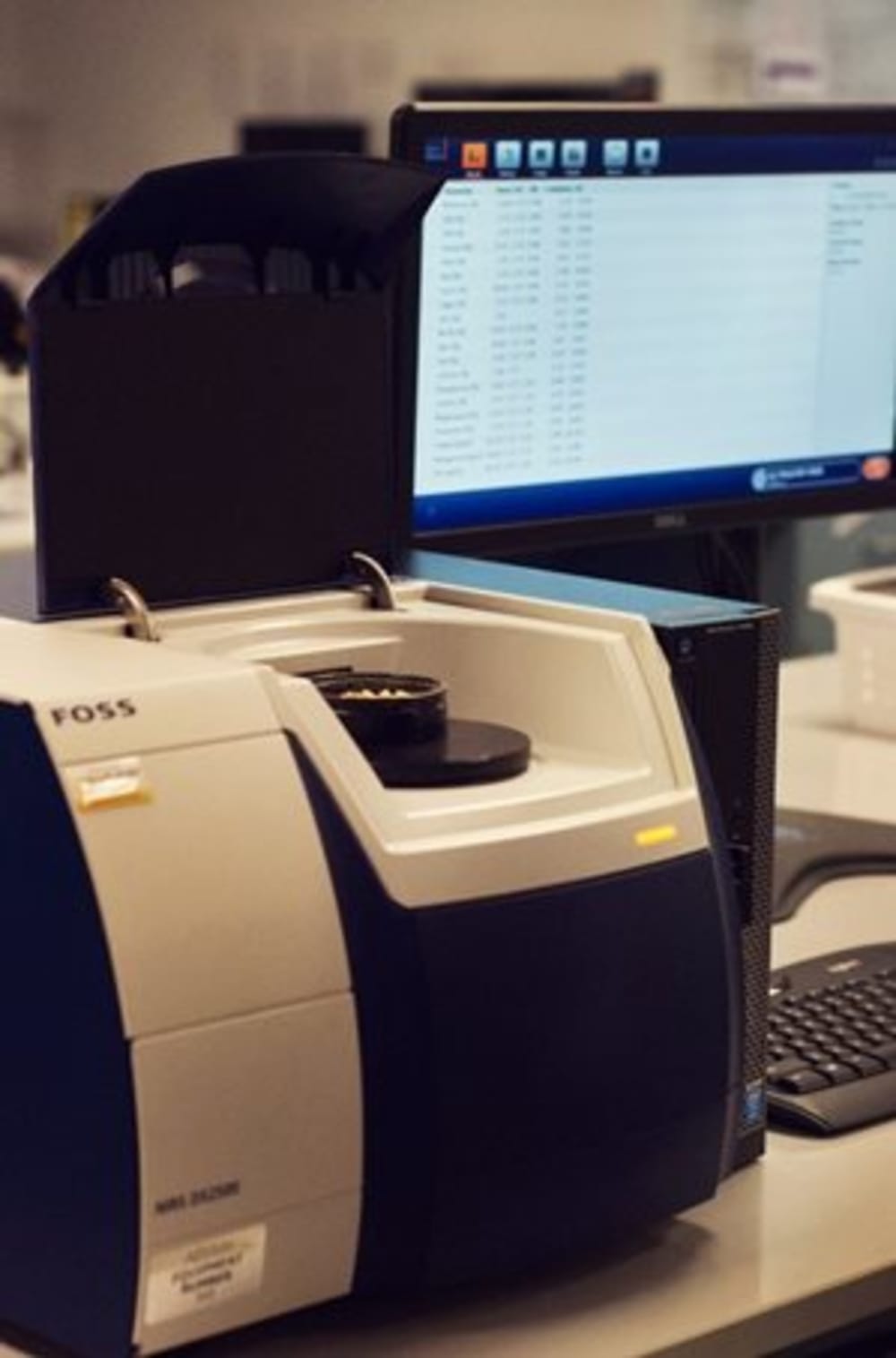
The source energy is sent through both a sample and a reference path, through a chopper to moderate the energy reaching the detector, and directed to a diffraction grating. This grating is similar to a prism. It separates the wavelengths of light in the spectral range and directs each wavelength individually through a slit to the detector.
Each wavelength is measured one at a time, with the slit monitoring the spectral bandwidth and the grating moving to select the wavelength being measured. This is then used to construct the spectrum.
Dispersive instruments have been around a long time and therefore are widely used.
3. Diode array (Perten, Zeiss, Foss)
In a diode array spectrophotometer, a light source illuminates the sample with white light. Some of the light is absorbed (depending on the composition of the sample) and the rest is reflected. The light which is reflected hits a stationary grating, which separates the light by wavelength, converting the white light into a spectrum.
Each wavelength is measured by a dedicated diode detector. With diode array technology all wavelengths are measured simultaneously, as each wavelength has a dedicated detector. One benefit of diode array technology is therefore the speed of measurement.
4. MEMS
The acronym MEMS (Micro-Electro-Mechanical Systems) is a rather generic catch-all term for any mechanical devices which is manufactured using silicon wafer technology derived from the semiconductor industry. The benefit of a MEMS system is that the size of the instrument can be greatly reduced, leading to the introduction of handheld NIR machines.
The portability of these devices provides great flexibility in which testing can take place and allows users to sample and test at many points in the process. MEMS systems are also extremely fast in collecting spectra, allowing many sub-samples to be scanned and averaged in the time it would take for a lab-based system to undertake a single scan. The downside is that they have smaller wavelength coverage and lower resolution, leading to a slightly higher error compared to the costlier lab-based instruments.
5. LVF (NIR4)
A linear variable filter (LVF) is a bandpass filter that has been intentionally wedged in one direction, providing a position-dependent dispersive optical element. LVF are ideally suited for use in compact instruments requiring high spectral resolution. The benefit of an LVF system is that the size of the instrument can be greatly reduced, providing flexibility and portability and allowing users to sample and test at many points in a production process.
Spectral range
The more critical issue is not how NIR machines generate a spectrum, but rather the range of wavelengths generated.
Figure 1: Wavelengths generated by different types of NIR machines
Some instruments go into the visible region (400-1000nm), but this is not important unless you want to measure pigments.
Generally the NIR region is considered to be 1100nm-2500nm. The spectra in this region are made up of overtones and combination bands, which result in a replicated spectrum. Some instruments only measure in the overtone region, whilst some provide information over the whole spectrum. Our findings show that instruments that cover the full wavelength range provide more accurate and reliable results.
Example spectrum
Figure 2: Example spectrum
Sample Presentation
The majority of NIR instruments on the market have a variety of accessories for presenting different types of samples. These vary considerably between instruments, having worked with all the instrument over a number of years, there is no clear winner. However, the newer instruments Bruker, Buchi, Foss XDS, Unity Top Loader, present the sample horizontally rather than the older Foss instruments that work with a vertical transport. The horizontal transport system has been found to be more user friendly.
Most NIR instruments have really been designed for solids; however, the Bruker MPA (Multi-Purpose Analyser) can be configured to do both solids and liquids on the same instrument.
Cost of Ownership
For all instruments, the ongoing costs will be for the source lamp (generally these last for 1 year; all are easy to self-fit and will cost between $100- $300). NIR cups are seen as consumables and use a high quality quartz glass; breakages are rare but can be costly. Most manufacturers would recommend an annual service, cost of which will vary depending on the supplier.
The dispersive instruments have some moving parts that may need replacing over the life of the instruments; FT-NIR have an internal laser that is seen as a consumable. The general life of an NIR instrument is high, and you should be able to rely on one for at least 10 years.
Software
Again all instruments come with their own proprietary software. This is usually split into two parts, the operating system & user interface and the calibration software. Again prices vary between vendors, but substantial saving can be made by purchasing readymade calibrations rather than buying the software to produce them internally.
Figure 3: Specification of different types of NIR machines
Conclusion
The best combination of accuracy, reliability and future proofing is provided by lab-based full range scanning NIR instruments. However, they can be more difficult to use and tend to have more complex software. The portable systems often provide a much easier user interface and have the benefit of being able to be taken around the production process.
Cost is obviously an important driver, as is support from the manufacturer. Once an NIR is installed and in use, it will become a vital part of the quality control system in place. It is essential that the supplier chosen is able to react quickly should the NIR breakdown or require updating.
We would expect a supplier to be able to react and resolve a problem within 24-48 hrs. This can vary between suppliers and countries, so it is important that these issues are resolved or understood prior to purchase.
Latest news
Stay ahead with the latest news, ideas and events.

Online Feed Fibre Calculator
Calculate the percentage of dietary fibre in your feed
Our calculator is designed for nutritionists and uses averages of global raw materials to calculate the dietary fibre content (plus other more in-depth fibre parameters) of finished animal feed. These parameters are available within AB Vista’s Dietary Fibre analysis service (part of our NIR service).
Sign up for AB Vista news
A regular summary of our key stories sent straight to your inbox.
SUBSCRIBE© AB Vista. All rights reserved 2025
Website T&Cs Privacy & Cookie Policy Terms & Conditions of Sale University IDC policy Speak Up Policy




















